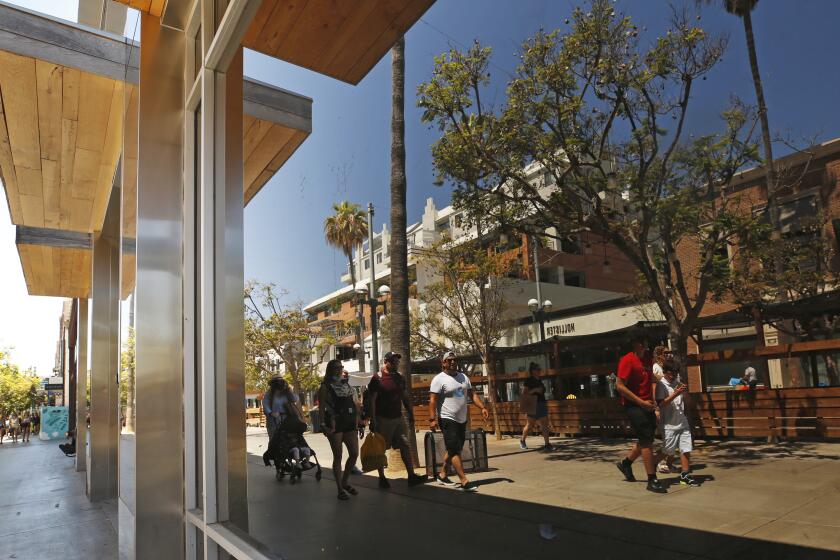Pining for Tree to Stand Its Ground
Crr-ACK! Kaa-BOOM!
A tremor akin to a 5.8 on the Richter scale shook the house. The 83-pound yellow Labrador leaped onto the bed, cramming his head under a pillow.
Instantly, I knew another Christmas tree had fallen.
The winds were howling in the predawn darkness with a fierceness I could not recall in my two decades in Canyon Country.
In Granada Hills, yes. The winds there were incessant around our hilltop tract home, rattling roof tiles as if an angry giant were madly punching fists across a keyboard and tossing patio umbrellas over the chimney like matchsticks.
In Granada Hills, we learned to listen for the hooting of an owl to signal the barrage would soon end.
It was the winds that pushed us to flee the hilltop in 1976, opting instead for a barren mini-ranch deep in a canyon. We gave up a view of twinkling lights and smog-shrouded freeways from an immaculate no-care lot. In exchange we got a retired cow pasture with half a dozen oak trees and fewer neighbors.
City warriors during the workday, we escaped in the evenings and on weekends to a serene and simple life, content to raise Arabian horses despite the tribulations of water wells that quit, propane tanks that freeze and rivers that make dirt roads impassible during storms.
“There are no trees here,” my mother-in-law confided over the phone to a friend, describing the view from her bedroom, adjacent to that of my daughter, then 9. “It’s so, so barren here.”
Indeed it was. Except for the distant oaks and a cluster of cottonwoods dangling an old tire swing, the green stucco of the new house loomed like a ship beached in a vast sea of gray-brown dirt, scraped clean by the earth grader and baked hard by the sun.
That prompted my dad on our first Christmas at the ranch to give each of his three daughters a living pine tree, all of which were then to be planted at our place after the holidays.
They were the first of our tedious landscaping projects, those 2.5-foot-tall Monterey pines generously spaced along the side of the house. Tiny green saplings with promise of a big future.
Only later, after trenching and laying miles of pipelines and digging hundreds of holes would there emerge today’s rose and vegetable gardens, fruit orchard and vineyard, sycamore grove, hedges, lawns and flower beds.
When my husband’s mother died, we added to the row of pines another tiny fir--a Christmas present from her friend--that she had nurtured for years in a pot on her dresser.
The pines grew. And they Grew. And they GREW.
“That one’s getting awfully close to the eaves,” I commented to my husband one day. “It could fall or cause damage.”
“Not in my lifetime,” he predicted, only too accurately.
Two years ago, the swelling branches began to push on the roof. The first of the Christmas trees was felled. Its neighbor, missing the support it once leaned on, toppled months later, slamming to the ground while no one was at home.
The third met its fate this month, at 4:40 one morning, during reports of the worst wind gusts in recent history. Its mighty trunk snapped six feet above the ground, directly outside my bedroom, then miraculously was deflected off the house.
Like a giant beached whale, the 70-foot downed fir was awesome, its branches, even while prone, arching 25 feet into the air. Its woody bulk smashed through the mock orange and laurel bushes, stretched through the lilacs, agapanthus and sweet alyssum, and sprawled into the frostbitten rose garden.
Now 22 Christmases after it went into the ground, I cut a few boughs to stuff into a vase in my living room, propping them up for a Charlie Brown tree that evokes giggles from the grandchildren.
“I don’t recommend that people plant this tree in our hot, dry climate,” said Nancy Roatcap, a veteran arborist who operates the Christmas Tree Farm in Valencia. “It’s a very soft-wooded tree that is better rooted in its natural habitat, which is the central coast of California. It needs lots of water.
“It gets too big for people’s lots--80 to 100 feet tall and wide-spreading. It takes about four prunings a year to keep its Christmas tree shape. It gets mites and borers and root rot. It’s just a very touchy tree.”
A better tree, she recommends, is the deodar cedar, “which isn’t a pine at all, but a cedar with needles.”
*
Like most Southern California Christmas tree farmers, Roatcap and her family--pioneers in the cut-your-own tree business for nearly 30 years--plant the Monterey pine almost exclusively.
The most popular holiday variety in the state, according to the California chapter of the National Christmas Tree Assn., the Monterey pine is fast-growing, reaching 6 to 12 feet in four years.
Seeds propagated in New Zealand, which uses the tree for timber, are disease-resistant and exported to the United States, where 33 million Christmas trees of all varieties are harvested yearly for the holidays.
Roatcap has 15,000 Montereys planted on nine acres of her Valencia farm, adding about 5,000 a year to keep the rotation going. Other family members grow the trees on 20-acre farms in Santa Paula and at Frazier Park, where they also nurture a few of the slow-growing and doubly expensive silver tip and white tip firs.
After studying agribusiness management at Cal Poly San Luis Obispo, and horticulture and landscape design at the University of Arkansas, Roatcap worked for a while at nurseries and as a landscaper in the South before rejoining her family in California.
Now 52 and single, Roatcap took over management of the Valencia farm from her father four years ago, plunging in with all of her savings, proceeds from the sale of a house, and a mounting load of credit card debt to restart the business.
She works the farm year-round with only one assistant, hiring extra help during December. Using a razor-sharp No. 8 lettuce knife, they coax each of the trees into shape with at least three prunings a year.
A white grub infestation--the larvae of the common June beetle--hit her farm in the first two years, wiping out half her seedlings. She turned to the Internet to find a cure--beneficial nematodes she imported into the fields from an Arizona research firm.
Because the grubs have a three-year life cycle in the soil, Roatcap also dips the roots of new seedlings into a solution containing milky spore disease--”Love Potion No. 9 for Christmas trees,” she calls it--which kills the grubs.
With Christmas now behind, her next task is to chop down about 400 trees left in this year’s cutting field, passed over by shoppers because they are too skinny and ugly. After all her work, that duty doesn’t bother her, she said, because the remaining trees “are the broccoli of the fields,” the unwanted leftovers. They will be replaced by new seedlings.
Roatcap estimates she sold about 2,600 trees this year, and could have sold 3,000 more if she had them. “By 2001, I should be rolling along,” she predicts.
Not me. Only one Monterey still stands in my former Christmas tree forest. The majestic pine is easily 80 feet tall, with a massive trunk and heavy branches towering far above the house. Squirrels compete to dominate the final domain, chattering at me as if demanding arbitration.
Will this tree, too, someday crash to the ground?
Naw, not in my lifetime.
More to Read
Start your day right
Sign up for Essential California for news, features and recommendations from the L.A. Times and beyond in your inbox six days a week.
You may occasionally receive promotional content from the Los Angeles Times.


![Stephanie Lazarus, a Los Angeles police detective charged with capital murder in the 1986 slaying of her ex-boyfriend's wife pleaded not guilty during her arraignment in Los Angeles Superior Court Monday morning, July 6, 2009. (AP Photo/Al Seib ,Pool)]](https://ca-times.brightspotcdn.com/dims4/default/189ca94/2147483647/strip/true/crop/2400x1605+0+76/resize/320x214!/quality/75/?url=https%3A%2F%2Fcalifornia-times-brightspot.s3.amazonaws.com%2F65%2Fe0%2F8228b5b44c0da5be07c48647ce71%2Fdetective-killing.JPEG)



